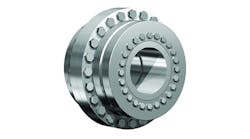Heavy-duty shaft couplings traditionally have used keyed connections that were over-engineered in terms of stiffness. That’s because engineers understood keyed connections and stiffness increased efficiency of torque transmission. They also have a long track record. But keyed coupling connections are also difficult and costly to assemble and align, they are limited in how much torque they could transmit, they are large and heavy, and they wear out quickly.
Now engineers have an alternative—flange couplings, which have been developed and refined by engineers at Ringfeder Power Transmission GMBH to use a mechanical shrink fit around the shafts. To connect a shaft to a hub, for example, the coupling has tapered thrust rings, an inner pressure ring, and a set of locking screws. Tightening the screws around the circumference of the flange coupling draws the thrust rings together, compressing the inner against the hub and the hub against the shaft. This reduces the stresses on the shaft compared to keyed connections. This lets the flange coupling handle up to twice as much load compared to similarly sized key connections.
Flanged couplings have several other advantages over keyed versions. Keyed couplings can weigh almost a ton, making alignment difficult. Flanged couplings also disassemble simply by just loosening the locking screws. Traditional shrink-fit couplings need to be heated for hours to expand the coupling’s inner diameter, a process that can damage parts.
When the flanged disc is installed, the shrink disc effectively seals the working surfaces against dust and debris. This can be a critical advantage in material handling applications and in dirty environments such as mines.
The flange coupling also distributes compression forces evenly around the shaft, preventing misalignments.
